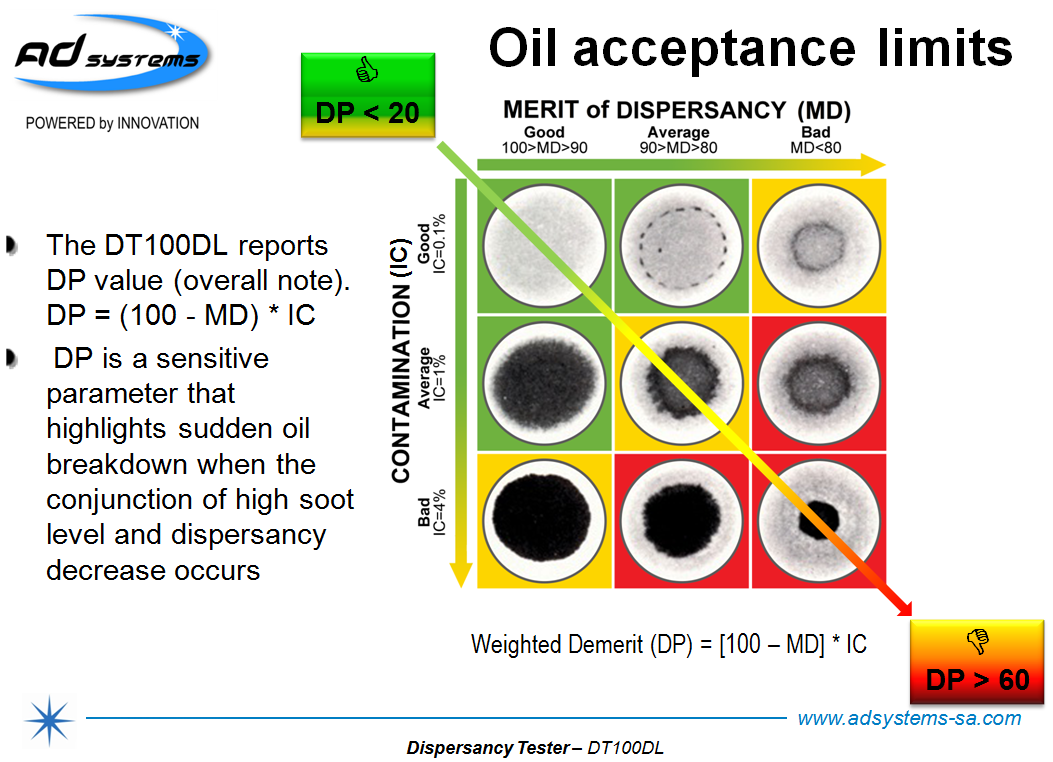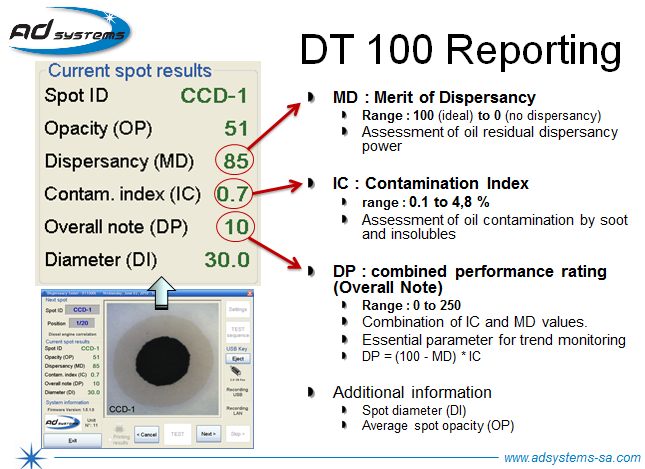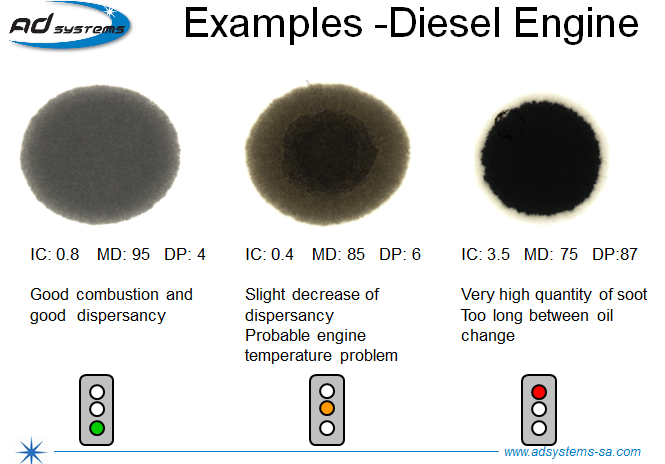DT100DL
Dispersancy of In-Service Engine Oils
Oil Conditions Monitoring
ASTM D7899
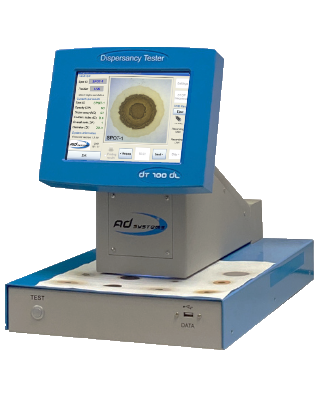
The requirement for on-line machinery and oil condition monitoring is becoming evermore apparent as maintenance costs increase and production capacity and equipment performance are maximized.
One of the primary functions of a lubricant is to preserve the cleanliness of a combustion engine's mechanical parts. The cleanliness of the mechanical parts is facilitated by "detergency" and "dispersancy" (DD) additives in the engine oil.

The DT100DL operates according to ASTM D7899. The instrument simultaneously measures soot and dispersancy. The results reported are combining soot content and dispersancy performance.
Oil Control Monitoring
Mining
Marine
A dedicated method is under approval process. This test method could be an alternative to very long and expensive test which is the engine test like DV4TD - CEC-L-93-04 where the pistons and rings are rated.
Phase 1 - a drop of oil is injected on a filter paper
Phase 2 - the drop spreads on the paper
Phase 3 - the oil with contained particles penetrate into the filter paper. The oil that is properly dispersing soot and other insolubles produces an evenly graduated spot. Dispersion characteristics of the oil are judged by how far oil drop spreads, how big the central sooty area is and how homogeneous the opacity of the spot is. The opacity of the spot will provide information on the oil contamination level. Though this method has proven effective, individual subjectivity in readings oil spots affects the reliability of results. To help oil analysts taking most advantage of this valuable traditional technique the company AD systems in cooperation with a lab dedicated in Oil Conditioning Monitoring (OCM) has developped a modern automatic instrument DT 100 offering significant increase in accuracy and repeatability of measurements. This new technique removes all the arbitrary aspect of the manual method.
Unique and simple instrument to measure dispersancy
Complete OCM program with unique information on oil dispersancy
Dispersancy measurement and soot content quantification
Tool to make justified pro-active actions and maintenance planning decisions
Removes all arbitrary aspects of manual method
Evaluation of oil formulation
Performance of DD additives
Ideal for trend analysis in OCM programs and diagnosis on diesel engines
Lubricants performance at engine operation conditions
Lubricants compatibility evaluation
The DT100 takes a spot image with a built-in digital camera. In seconds, the software scans and analyzes all the different areas of the oil spot and automatically calculates the quantitative quality parameters of a motor oil in service. The DT100 has been designed to satisfy needs of OCM laboratories. It is an easy-to-use and robust analyzer equipped with enhanced quality and communication features. The spot images can be stored on USB storage devices and sent to local networks (LIMS) with an Ethernet interface. Versatile communication protocol is configurable for the specific requirements of each laboratory. The DT100 provides fully traceable electronic data storage eliminating the need for paper archiving. A laboratory technician can perform on-site calibration in minutes using a standard calibration tool supplied with the instrument. The DT100 complies with modern QA/QS laboratory practices.
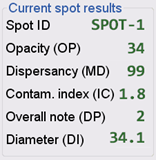
Example
MD = 0 = poor dispersion: the insolubles are all concentrated in the centre of the oil spot in the test; the residues are flocculated.
MD = 100 = excellent dispersion: the distribution of the insoluble on the filter paper is homogeneous.
The demerit points (DP) figure reflects the overall condition of the oil, as it is a combination of the IC and the MD derived from the calculation DP = (100 - MD) x IC. A low DP (0 or close to 0) indicates slight contamination and excellent dispersancy. A high DP (approaching 100 or more) indicates heavy contamination and/or a poor dispersancy
| Technical Points | Description |
| Dispersancy(MD) | 100 (good) to 0 (verypoor) |
| Contamination index(IC) | 0.1 to 5% |
| Combined Performance Rating(DP) | 0 (good) to 200 (very poor) |
| Duration of spot analysis | Few seconds per spot |
| Max spot diameter | Up to 45 mm |
| Positionning of the spot | Visual centering with guide |
| Imaging system | color CCD camera |
| Light source | Dual lighting - backlight and front light LED panels |
| Calibration of imaging system | Special calibration tool (delivered with the unit) |
| Results storage | Unlimited, depends on external USB storage device capacity |
| Spot image storagel | Color image in front light and B&W image in backlight |
| Data output | 2xUSB, LAN connectivity by Ethernet RJ45, optional printer |
| Dimensions (mm) | 305 x 487 x 390 (W x D x H) |
| Weight | 20kg |
| Electrical | 115 to 230V - 2A - 50/60Hz |
| Catalog Number | Description | Picture |
| AA110-002 | Dispersancy Tester - DT100DL with Dual Light and color camera Dual Light option allows taking color spot pictures in front lighting for archiving and reporting purposes. The equipment is delivered with a set of 100 filter paper Durieux_n122 260 x 260 mm, 3 sets of filter supports, calibration kit, and user manual in English. |
 |
| Catalog Number | Description | Picture |
| AK000-001 AK000-002 |
Printer 112mm 230V 50/60Hz Industrial thermal printer. Delivered pre-configured, with cable, adapter and 1 paper roll Printer 112mm 115V 50/60Hz Industrial thermal printer. Delivered pre-configured, with cable, adapter and 1 paper roll |
 |
| AK000-004 | Micro-Pipette 20µL Adjustable Volume |  |
| AK110-001 | 260 x 260 mm PAPER HOLDER 16 holes diameter 50mm, spaced out by 65 mm |
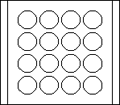 |
| AK110-004 | Micro-Pipette Drop Guide Designed to assist lab technician in making repeatable oil drops. The guide is placed on the hole in the filter holder and assure vertical position of the micro-pipette tip in the center of the hole and always on the same distance to the filter paper. The technician just needs to push the piston to get a perfect drop. |
 |
| AK110-002 | DT100DL Calibration kit |  |
| Catalog Number | Description | Picture |
| AC110-001 | Set of 500 filter paper 260 x 260 mm Durieux n122 grade AD Systems certifies the quality of this filter paper |
 |
| AC000-001 | Set of 10 printer paper rolls |  |

